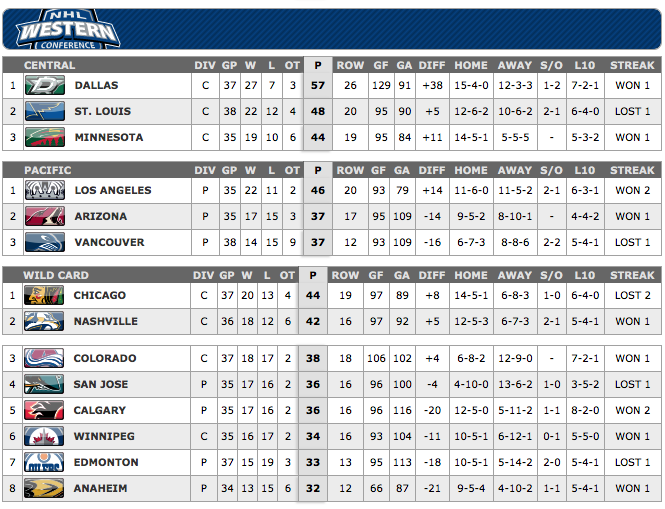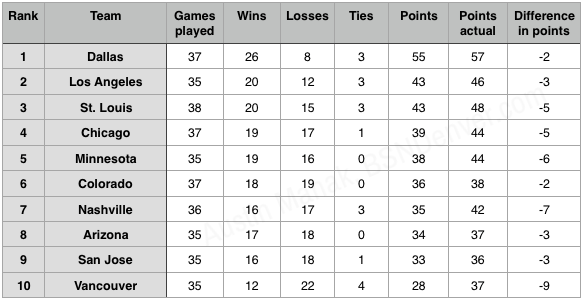© 2025 ALLCITY Network Inc.
All rights reserved.

Two of the biggest changes implemented by the NHL over the last two decades were the removal of ties (with the corresponding addition of the infamous loser point) and more recently, the realignment of divisions (with the corresponding decision to make playoff births dependent on divisional standings rather than conference standings).
Ties were not unique to hockey, as Europeans have embraced the draw as a part of the game of soccer for decades. I loved the tie in hockey. On some nights, teams just deserve to split the points and move along in their seasons, without any gimmicky mechanisms to force a winner.
However, the NHL felt the majority of North American fans crave winners and losers, and decided ties were holding the game back. After the lockout of 2004-05, the NHL implemented the shootout, a skill competition of skater vs. goalie, mano a mano. Ties were as extinct as the three-horned triceratops, but three-point games were upon us in full force. You see, the NHL decided a team losing in a shootout or overtime should be rewarded for “getting close to winning,” so they receive a point in the standings, with the winner receiving their usual two points.
What this has done is inflate the standings to a degree, and keep more teams in the running for a playoff berth deeper into the season. Fans are guaranteed to see their team win or lose if they buy a ticket to the arena. A brilliant PR tactic by the NHL, but at the risk of competitive fairness?
Division realignment was a necessity due to the north Canadian, Winnipeg Jets, playing in the Southeast division after relocating from Atlanta. The NHL condensed the league from six divisions to four, with tight-knit geographic factors in mind.
A thrashing to the old playoff system was also in order. Since my childhood days, the NHL always had the top eight teams of each conference qualify for the playoffs. The league would then face off seeds 1 vs. 8, 2 vs. 7, 3 vs. 6, and 4 vs. 5 in the first round, and reseed as necessary each round until the Stanley Cup Final.
In an effort to spice up division rivalries, the league decided to qualify the top three teams from each new division to the playoffs, with two wild-card teams getting tickets to the best tournament in professional sports as well.
Under these rules, teams within the same division are scheduled to play each other in the first two rounds of the playoffs. Rivalries. Rivalries. Rivalries. The only exception being, if both wild-card teams are from the same division, one gets tossed in with the three playoff teams of their conference counterpart division.
In my opinion, this is actually a good move for the league, as a little animosity in the postseason adds boatloads of intrigue and excitement to the game that can last for years.
Just look at the Avalanche and Red Wings rivalry of the late 1990s. They met in the playoffs five times from 1996-2002, and three times in the Western Conference Final. The two teams combined to win five Stanley Cups over that stretch, with three of those Cup wins coming after one team disposed of their arch-rival along their playoff path.
However, does the divisional playoff format come at the price of competitive fairness?
Now that we have gotten a little history out of the way, let’s fast forward to today.
As of this morning, here is how the official standings look, via NHL.com:
As you can see, the Colorado Avalanche are currently on the outside of the playoff picture looking in. A strong 9-3-1 record in the month of December has closed the gap between the Avs and their Central Division competition, but there is certainly still a gap and work to be done in 2016.
Upon closer inspection of these standings, and how teams have accumulated their points, there are a few nuisances that are really hurting the Colorado Avalanche right now. You guessed it — the “loser point” and divisional realignment.
The Avalanche actually sit seventh in the Western Conference in points, which would have been good enough to get them in the playoffs prior to the 2013-14 season. The quality of competition in the Pacific Division bows feebly to the bear-house that is the Central Division, which is why Arizona sits second in the Pacific but would be sixth in the Central.
Alas, it is the Avalanche who sit sixth in the Central.
Digging deeper still, I reformulated the standings to reflect how the Western Conference would look with the removal of loser points and reintroduction of ties:
This is one way to bridge the gap, and get the Avalanche from the cold and desolate region outside the postseason over the threshold to the warm cozy confines of teams playing for Lord Stanely’s chalice next spring.
The Avs rank sixth in the west with 18 regulation/overtime wins, and are second in the conference with 106 goals scored. Only the powerhouse Dallas Stars have lit more lamps than Colorado.
As you can see by the “difference in points” column, all of the teams the Avalanche are chasing have benefitted more from the loser point than the Avalanche have. The Avs would only have two fewer points without the loser point this season. Nashville and Minnesota have already racked up six loser points, and Nashville collected a pair of bonus points for their two shootout wins. Colorado and Minnesota have yet to go to a shootout this season.
Under the W-L-T format of old, Nashville would be awarded a point for tying for each of their three shootout games, and wouldn’t receive any standings points for losing. The Avalanche would be a point ahead of Nashville in the standings instead of four points back.
The gap between Minnesota and the Avs would close from six points to two, and the Avalanche would only be three points behind the defending Stanley Cup champion, Chicago Blackhawks. A small caveat being, we likely wouldn’t have 3-on-3 overtime under the W-L-T format, which is a factor in the games that have been played this season.
The travesty of the loser point is on full display when you look at the Vancouver Canucks. Vancouver has won 12 games this season that have not gone to shootouts. Their record is a dismal 12-22-4 if you remove loser points and award ties for the four shootout games the Canucks have played.
Yet, the Canucks have been awarded nine points in games they have lost this season, which is 25% of the points the Avalanche have earned in their 18 wins. The Canucks also play in the Pacific Division, which means if the playoffs started tonight, Vancouver would open up a first round series against the Arizona Coyotes.
How fitting, that one of the worst teams in the Western Conference would not only qualify for the playoffs, but wouldn’t even have to play one of the powerhouses of the league. Instead the Canucks would be thanking their lucky stars that they would square off against a mediocre Coyotes team.
The good news is, there is a lot of season left to be played, and the Avalanche have every opportunity to go out and earn a playoff spot. They can point to divisional alignment and loser points as excuses, but can also look in the mirror for reasons as to why they face an uphill battle over the second half of the season.
The Avs were a playoff afterthought entering December, with a dismal 9-14-1 record. They have lost a league-high three games in regulation when leading after two periods this season, and recently blew a fourth game when leading after two to the Arizona Coyotes (although the Avs did receive an infamous loser point). Had they held those leads, they’d be right up there with the Wild, Blackhawks, and Predators.
Although the Avs control their fate, these divisional issues and the loser point are still something to keep an eye on. For my two cents, I’d bring back ties, but I digress. If the gap between the Central and Pacific continues to grow over the course of the season, and teams like Vancouver keep padding their point totals with loser points, there could be some injustice when the eight Western Conference playoff participants are determined.
Right now, it looks like the team most likely to be subjected to that potential injustice is the Colorado Avalanche. But hey, Gary Bettman enjoys being booed at the draft, so maybe he’s not worried.
Comments
Share your thoughts
Join the conversation




